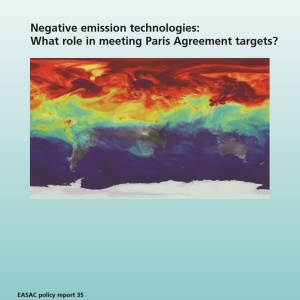
A report by the European Academies’ Science Advisory Council finds that negative emissions technologies (NETs) have ‘limited realistic potential’ and cannot be relied upon to remove carbon at the rate envisaged in the Intergovernmental Panel on Climate Change (IPCC) scenarios for avoiding dangerous climate change.
NETs have received much attention recently because of the difficulty of reaching net zero emissions by 2050 without them, as required by the Paris Agreement on climate change to curb warming to ‘well below 2°C above pre-industrial levels’, preferably 1.5°C. The IPCC assumes the large-scale use of NETs in 344 of its 400 scenarios that give a 50% or better chance of staying under 2°C of warming. NETs may have to remove between 7 and 70 Gt CO2 each year to help meet the Paris Agreement targets, as shown in the table below.

The report sets out the main categories of NETs as:
- Afforestation and reforestation
- Land management to increase carbon in soils
- Bioenergy production with carbon capture and storage (BECCS)
- Enhanced weathering
- Direct capture of CO2 from ambient air with CO2 storage (DACCS)
- Ocean fertilisation to increase CO2
- Carbon capture and storage (examined because it is a required component of BECCS and DACCS)
The report examines the pros and cons of each technique and summarises its results in the table below. It is difficult to calculate the total carbon reduction potential of all of the NETs, because of the competition between them for resource use (e.g. land), their uncertain technical, economic and ecological viability and the risk of NETs actually releasing more carbon into the atmosphere. The report does not actually present a figure for the total carbon removal potential of all NETs together.

The report concludes that mitigation should be pursued urgently because of the uncertain viability of NETs. Existing deforestation should be slowed and reversed. Carbon capture and storage should continue to be developed, since it is needed for BECCS and DACCS.
Download the full report here. You may also find this paper useful: The trouble with negative emissions. See also the FCRN’s summary Potentially dangerous consequences for biodiversity of geoengineering, which mentions the damage to biodiversity that BECCS could cause, and the Foodsource building block What is land use and land use change?







Post a new comment »